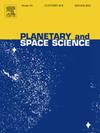Seismic wave experiments in granular media with applications to asteroids
IF 1.7
4区 物理与天体物理
Q3 ASTRONOMY & ASTROPHYSICS
引用次数: 0
Abstract
Observational data support the view of asteroids as granular systems. Characterizing their mechanical properties is crucial for space mission planning, assessing Earth’s impact risks, and understanding solar system origins. In this context, we present a laboratory-scale experiment aimed at examining wave propagation in granular media. Our findings demonstrate that the propagation of observed waves at 500 Hz shows significant attenuation with an estimated value of Np/m. Additionally, we observe an increase in wave speed with confining pressure, which follows a dependency on , interpreted as mesoscopic nonlinear elasticity. This indicates that a confined granular medium behaves as a nonlinear consolidated medium. Furthermore, we establish the equivalence of propagation properties between impact and vibration by supporting our experimental data analysis with numerical simulations. Applying our findings to model wave propagation in a low-gravity setting involving Dimorphos’ mass and geometry, our laboratory-based approach offers a cost-effective alternative to in situ measurements.
颗粒介质中的地震波实验及其在小行星上的应用
观测数据支持小行星是颗粒系统的观点。描述它们的机械特性对于空间任务规划、评估地球撞击风险和了解太阳系起源至关重要。在这种情况下,我们提出了一个实验室规模的实验,旨在检查波在颗粒介质中的传播。我们的研究结果表明,在500 Hz下,观测波的传播表现出明显的衰减,估计值为α=(1.8±0.2)Np/m。此外,我们观察到波速随围压的增加而增加,这取决于p1/2,这被解释为介观非线性弹性。这表明受约束的颗粒介质表现为非线性固结介质。此外,我们通过数值模拟来支持我们的实验数据分析,建立了冲击和振动之间的等效传播特性。将我们的研究结果应用于低重力环境下涉及Dimorphos质量和几何形状的波传播模型,我们基于实验室的方法为原位测量提供了一种经济有效的替代方法。
本文章由计算机程序翻译,如有差异,请以英文原文为准。
求助全文
约1分钟内获得全文
求助全文
来源期刊

Planetary and Space Science
地学天文-天文与天体物理
CiteScore
5.40
自引率
4.20%
发文量
126
审稿时长
15 weeks
期刊介绍:
Planetary and Space Science publishes original articles as well as short communications (letters). Ground-based and space-borne instrumentation and laboratory simulation of solar system processes are included. The following fields of planetary and solar system research are covered:
• Celestial mechanics, including dynamical evolution of the solar system, gravitational captures and resonances, relativistic effects, tracking and dynamics
• Cosmochemistry and origin, including all aspects of the formation and initial physical and chemical evolution of the solar system
• Terrestrial planets and satellites, including the physics of the interiors, geology and morphology of the surfaces, tectonics, mineralogy and dating
• Outer planets and satellites, including formation and evolution, remote sensing at all wavelengths and in situ measurements
• Planetary atmospheres, including formation and evolution, circulation and meteorology, boundary layers, remote sensing and laboratory simulation
• Planetary magnetospheres and ionospheres, including origin of magnetic fields, magnetospheric plasma and radiation belts, and their interaction with the sun, the solar wind and satellites
• Small bodies, dust and rings, including asteroids, comets and zodiacal light and their interaction with the solar radiation and the solar wind
• Exobiology, including origin of life, detection of planetary ecosystems and pre-biological phenomena in the solar system and laboratory simulations
• Extrasolar systems, including the detection and/or the detectability of exoplanets and planetary systems, their formation and evolution, the physical and chemical properties of the exoplanets
• History of planetary and space research
 求助内容:
求助内容: 应助结果提醒方式:
应助结果提醒方式:


